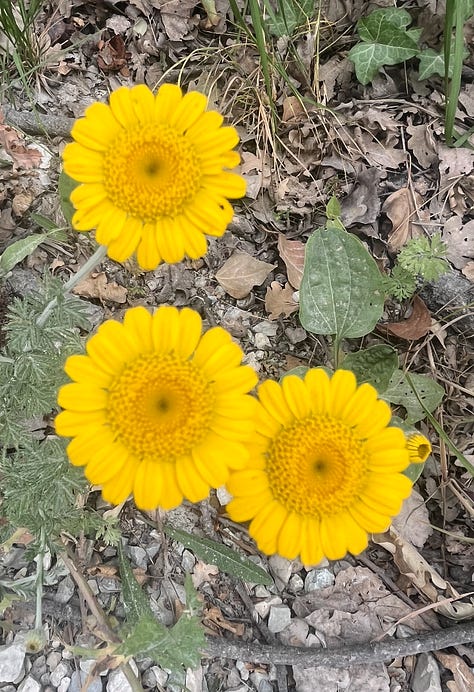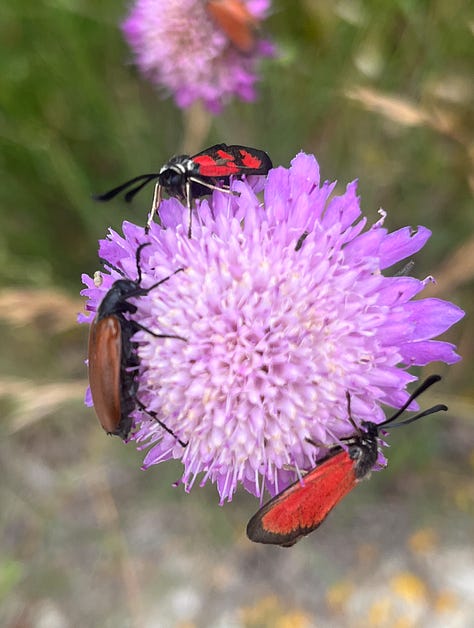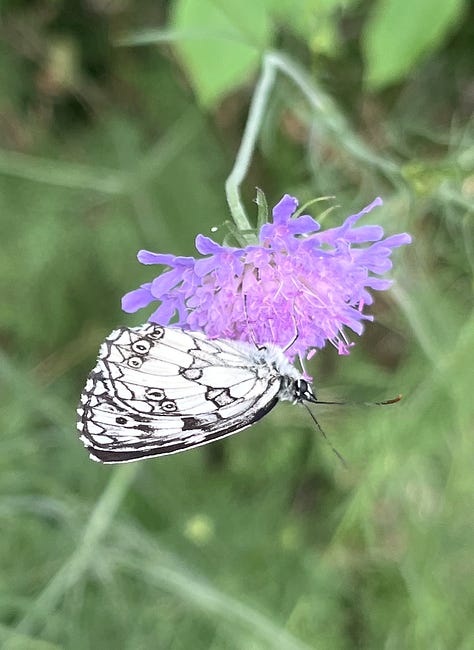I am currently in Italy, keen to see the spring wildflowers and to observe the land at its most verdant.
This week’s newsletter will cover a few different subjects - the native Italian wildflowers, fireflies and foraged wild fennel.






Italy’s Wild Flowers
Around 130 million years ago, the first flowering plants, known as angiosperms, appeared. At the time, the only plants growing were ferns, mosses and conifers, non-flowering plants known as gymnosperms. A plant producing scent, nectar, and colourful petals was a big evolutionary development.
Over millions of years, flowering plants have spread and diversified, becoming the most successful group of plants on Earth.
What makes a wildflower special is that it grows naturally, without human cultivation, in a particular place. Each country has its own set of native wildflowers that evolved over thousands, sometimes millions, of years.
Wildflowers purpose is to provide food and shelter for pollinators (nectar) and birds / other mammals (seeds and berries), as well as their roots stabilising the soil. So, wherever you are in the world, the wildflowers growing locally are the result of a long, local evolution.
So let’s look at a few of my favourite Italian wildflowers spotted this spring:
1 - Pacific Pea (Lathyrus vestitus)


Identification: A scrambling or climbing plant with bright pink flowers. Unlike sweet peas, this one has no scent. It clings with branched tendrils and forms trailing mats or climbs over other vegetation. (Not native to Italy and instead, North America)
Habitat: Roadsides, field edges, scrubby slopes, and disturbed ground.
Pollinators: Particularly bumblebees and honeybees, which are strong enough to open the flower's keel* to access nectar and pollen (a petal structure that must be pushed down to expose the reproductive parts and access the nectar).
Fun fact: Some wild peas produce chemicals that taste bitter to stop hungry insects and animals. Yet, certain insects have evolved to tolerate those chemicals and feed on the peas without harm.
Golden Marguerite / Dyer’s Chamomile (Cota tinctoria, formerly Anthemis tinctoria)


Identification - A bushy plant with finely divided, ferny foliage and bright yellow daisy-like flowers. The central disc is large and golden, and the rays are uniform and slightly rounded. (Native to south-eastern Europe and western Asia, however has naturalised in many parts of Italy)
Habitat - Sunny, dry meadows, rocky slopes, roadsides, and scrubby areas.
Pollinators - Bees, hoverflies, butterflies, and other nectar-loving insects. Its long flowering season makes it valuable in pollinator-friendly planting.
Fun fact - It was historically used for yellow dye, hence its common name, “Dyer’s Chamomile”.
Pyramidal Orchid (Anacamptis pyramidalis)


Identification - Dense, cone-shaped cluster of small, pink to purplish flowers. Pyramid-like shape when in flower. (Native to Italy, as well as Europe, North Africa and parts of western Asia)
Habitat - Dry grasslands, meadows, limestone hillsides,
Pollinators - Day-flying moths and butterflies, particularly species with long proboscises.
Fun fact - The flower’s shape is especially adapted to moth pollination. Also, this orchid relies on a special underground fungal partner (a mycorrhiza) to both grow and germinate.
Field Scabious (Knautia arvensis)


Identification - A tall, wiry-stemmed wildflower with soft lilac to mauve blooms held in neat, rounded pincushion-like heads. The flowers are made up of many small, tubular florets with frilly outer petals. Leaves are softly hairy and often deeply lobed.(Native to Italy)
Habitat - Dry meadows, grassy roadsides, open woodland edges, and calcareous hillsides. Thrives in sunny, undisturbed areas with well-drained soil – commonly seen in Italy’s rural landscapes and wildflower-rich pastures.
Pollinators - Great for many pollinators, specially bumblebees, hover flies, honeybees, and butterflies. It provides long-lasting nectar through summer, making it a favourite in pollinator-friendly planting.
Fun Fact - it was once believed to cure scabies and bubonic plague. Its name comes from the Latin scabere, meaning to scratch, because people thought its roots and leaves could soothe itchy skin conditions and help with sores.



Chicory - Cichorium intybus


Identification - tall, upright wildflower with stiff, branching stems and blue, small, daisy-like flowers with fringed, notched tips. The flowers open in the morning and will close by the afternoon, each flower only lasting one day! (Native to Italy as well as other parts of Europe, North Africa, and western Asia)
Habitat - warm, dry, and often poor soils, enjoying roadsides, grassy banks, dry fields, and the edges of cultivated land.
Pollinators - Bees (especially solitary species), hover flies and some butterflies.
Fun fact - It is in fact edible, both the flower and the leaves - the young leaves are bitter and often foraged for salads! The roots can also be eaten and, when roasted, have supposedly long been used as a coffee substitute during times of scarcity.
Native Italian butterflies and moths
1 - Marbled white butterfly
2 - Cinnabar moth
3 - Small skipper moth
4 - Meadow brown butterfly
5- Nine-spotted moth





Fireflies - Luciola italica
Where I am staying a sea of fireflies come out like clockwork at 9pm each evening. They move slowly, humming around the back garden, creating such a beautiful scene - it was hard to believe they were existing before my eyes.
Fireflies are beetles, in the Lampyridae family, thriving in meadows, woodland edges, riverbanks and old orchards or rural gardens. They need dark, undisturbed habitats with moisture, leaf litter and/or long grass for their larvae.
Their glow comes from a chemical reaction called bioluminescence. The males flashing and flying, while the females sit in the grass and respond with their own light. The flashing is courtship and each species has its own language of lights.
They aren’t pollinators and don’t feed on nectar. Interestingly, some species of fireflies don’t eat at all once they reach their adult form, while others feed on small insects or sap.
Wild fennel
Italian wild fennel - delicious added to salads or roasted with vegetables or sausages, ideally added to pickles!
Feathery, thread-like leaves with tall, hollow green stems. During summer it has umbels of yellow flowers. It can be spotted in sunny, dry places, mostly roadsides, field edges, olive groves or even cliffs.
To be sure it is fennel, you can crush a leaf and it should produce a sweet, liquorice-like flavour and scent. Unlike bulb fennel (finocchio), wild fennel doesn’t form a swollen base.
Talking of pickles, I have found my new favourite brand, check them out here: Goat Rodeo Goods. One of the co-founders also has a Substack newsletter too!
They are a very charming company based in Scotland! Yum yum!






